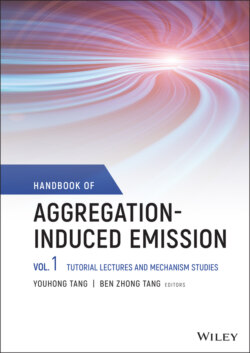Читать книгу Handbook of Aggregation-Induced Emission, Volume 1 - Группа авторов - Страница 24
1.6.1 Clusterization‐Triggered Emission
ОглавлениеTraditional luminogens, generally, consist of aromatic groups or other conjugated building blocks and take the two‐dimensional conjugated structure connected by chemical bonds. In such molecular systems with TBC, the EVC between emissive states and the ground state, the access to CIs, or the dark states driven by molecular motions are usually the detrimental causes for emission quenching. However, researchers have discovered and developed a nonconventional type of luminogens without any long‐range conjugated structures but containing only isolated units such as heteroatoms with lone‐pair electrons, unsaturated C=C, C=O, and C≡N groups as presented in Figure 1.10. Although this kind of luminogens lacks luminescent centers intuitively, and they are almost nonemissive in the dilute solution, they can emit visible light efficiently in the aggregate or solid state, showing the typical AIE behaviors. Because of the lack of largely conjugated luminescent centers and much higher motion ability than the traditional molecules with long‐range conjugation, such nonconjugated molecules are nonemissive in the isolated state. However, it can be noticed that these heteroatom‐containing groups usually exist as amide, imide, ketone, anhydride, or ester subunits connected by the saturated bonds in the macromolecule backbones, and they are usually rich in electrons. Hence, once the aggregation or cross‐linking occurs, electron‐rich moieties can cluster together and form a relatively stable long‐range through‐space electron ocean and energy bands by the electron overlapping for the electronic transition, which is similar to the energy band structures in the inorganic semiconductors. Upon excitation, electrons can jump into the excited state based on the stabilized through‐space energy bands and light up the whole cluster system.
Such nonconventional phenomenon has been coined as CTE; it deciphers that the severe molecular motions and nonconjugated structures make the CTE luminogens nonemissive in the isolated state or the dilute solution, whereas diverse intra‐ and intermolecular interactions in the cluster or cross‐linking can hamper the molecular motions and stabilize the conformations with large electron overlapping and thus boost the light emission of CTE luminogens, in which the packing density and the cluster size can affect the emission efficiency [21]. Taking the polyacrylonitrile (PAN) [21b] and poly(N‐hydroxysuccinimidyl methacrylate) (PNHSMA) [21c] as the example, they contain no aromatic groups and are nonconjugated in the isolated polymer backbone (Figure 1.10c). Therefore, these two molecules are nearly nonemissive in the dilute solution. But they can emit strong blue light in the concentrated solution or solid powder. CTE phenomenon also exists in the natural products such as starch, cellulose, and protein; they can show notable blue light in the solid state under UV excitation [21d].
Figure 1.10 (a) Schematic illustration of the cluster formation, energy variation, and (b) the formation of through‐space conjugation involved in the CTE.
Source: Adapted from Ref. [21a] with permission from Elsevier.
(c) Examples of CTEgens.
Source: Adapted from Ref. [21b] with permission from John Wiley and Sons.
